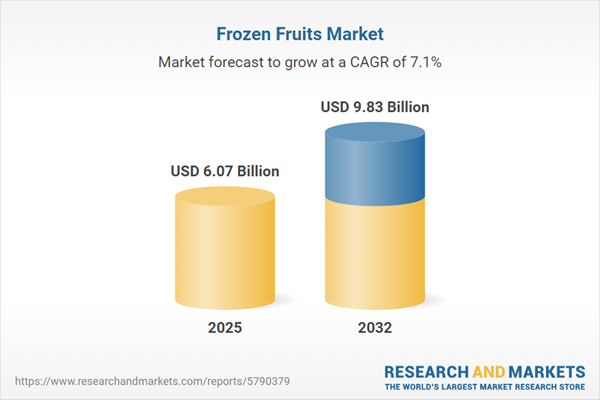Speak directly to the analyst to clarify any post sales queries you may have.
The frozen fruits market is transforming as industry leaders adapt to complex regulations, evolving buyer requirements, and intensifying operational expectations. For senior decision-makers, achieving sustainable growth now demands focused strategies designed to bolster resilience and adaptability across increasingly interconnected supply networks.
Market Snapshot: Frozen Fruits Market Growth and Momentum
The global frozen fruits market is experiencing stable value growth as commercial buyers raise expectations related to food safety, nutrition, and convenience. Retailers and foodservice providers are prioritizing advanced freezing technologies and distribution enhancements, reflecting a sector-wide push toward quality, reliability, and responsive customer service. Both established and emerging suppliers are streamlining supply approaches and upgrading digital infrastructure in response to raised industry standards. Recent investments in facility modernization and integration of digital monitoring demonstrate a concerted commitment to measurable product consistency and improved operational outcomes. This ongoing momentum is shaping a market defined by adaptability and upgraded stakeholder alignment.
Scope & Segmentation: Strategic Market Breakdown
- Fruit Types: Berries, citrus, tropical fruits, mangos, and stone fruits address a broad set of consumer choices and regional consumption trends.
- Packaging Formats: Bags, boxes, plastic containers, bulk units, cups, pouches, and trays serve varying commercial applications and further the transition to sustainable packaging strategies.
- Sourcing Approaches: Conventional and organic options enable compliance with shifting regulations while supporting transparent, traceable supply chains through globally recognized certification programs.
- Product Forms: Blocks, concentrates, purees, or individually quick frozen items provide versatile options for commercial and institutional buyers meeting operational demands.
- End Uses: Hospitality, foodservice, and household channels each influence product development based on operational and consumer requirements.
- Distribution Channels: Retail and digital sales platforms, integrated within omnichannel infrastructure, make procurement more straightforward for B2B customers and accessible to various end users.
- Regional Markets: North America, Latin America, Europe, Middle East, Africa, and Asia-Pacific represent key markets, each with distinct regulatory and infrastructure priorities. Innovation is often driven by leading nations such as the United States, Canada, Brazil, Germany, China, and India.
- Key Market Players: Dole Food Company, Conagra Brands, Bonduelle, Greenyard, Naturipe Farms, Driscoll’s, Hortex Holding, FRoSTA Aktiengesellschaft, Pacific Coast Fruit Company, and AGRANA Beteiligungs-AG are actively refining processes and championing the adoption of new technology to enhance global supply chain productivity.
Key Takeaways for Decision-Makers
- Enabling traceable sourcing and robust certification supports greater supplier transparency and strengthens relationships throughout B2B networks.
- Deployment of advanced freezing methods such as cryogenic and high-pressure systems maintains product stability for extended supply chains.
- Sustainability measures, including eco-friendly packaging and ethical procurement, are bolstered by blockchain for full-spectrum compliance and traceability.
- Expanding procurement models, particularly through direct and subscription-based services, delivers improved reliability for evolving customer segments.
- Modern packaging initiatives enhance alignment with clients’ environmental targets, solidifying partnerships where sustainability is a competitive differentiator.
- Regional developments influence market strategy, with North America emphasizing logistics, Europe foregrounding regulatory compliance, and Asia-Pacific fostering product diversity and technology-driven oversight.
Tariff Impact: Navigating Regulatory Shifts
Recent changes in United States tariffs have encouraged suppliers to adjust sourcing and pricing strategies. Industry leaders are widening supplier networks, deepening strategic alliances, and upgrading cold chain infrastructure, allowing for operational resilience against evolving import-export requirements. Cross-sector collaboration is proving essential for sustaining robust trade flows and mitigating disruption due to regulatory adjustments within the frozen fruits market.
Methodology & Data Sources
This report draws from the latest academic research, leading trade publications, and direct interviews with senior industry executives and supply chain practitioners. Each data point is rigorously validated, and comprehensive thematic analysis ensures decision-makers have access to reliable, action-oriented intelligence.
Why This Report Matters
- Enables executive teams to adapt strategic approaches in response to global frozen fruits market regulation, digital transformation, and operational innovation.
- Delivers clear segmentation and regional insights, guiding targeted resource allocation and discovering emerging growth areas.
- Offers benchmarks to advance sustainability, support expansion into digital commerce, and implement distribution models that reflect B2B sector requirements.
Conclusion
Effective participation in the frozen fruits market now requires agile strategies and operational innovation. Senior leaders who champion adaptability position their organizations for sustained relevance and improved outcomes amid dynamic industry change.
Additional Product Information:
- Purchase of this report includes 1 year online access with quarterly updates.
- This report can be updated on request. Please contact our Customer Experience team using the Ask a Question widget on our website.
Table of Contents
3. Executive Summary
4. Market Overview
7. Cumulative Impact of Artificial Intelligence 2025
Companies Mentioned
The companies profiled in this Frozen Fruits market report include:- Dole Food Company, Inc.
- Conagra Brands, Inc.
- Bonduelle S.A.
- Greenyard N.V.
- Naturipe Farms, LLC
- Driscoll's, Inc.
- Hortex Holding S.A.
- FRoSTA Aktiengesellschaft
- Pacific Coast Fruit Company
- AGRANA Beteiligungs-AG
Table Information
| Report Attribute | Details |
|---|---|
| No. of Pages | 195 |
| Published | November 2025 |
| Forecast Period | 2025 - 2032 |
| Estimated Market Value ( USD | $ 6.07 Billion |
| Forecasted Market Value ( USD | $ 9.83 Billion |
| Compound Annual Growth Rate | 7.0% |
| Regions Covered | Global |
| No. of Companies Mentioned | 11 |









